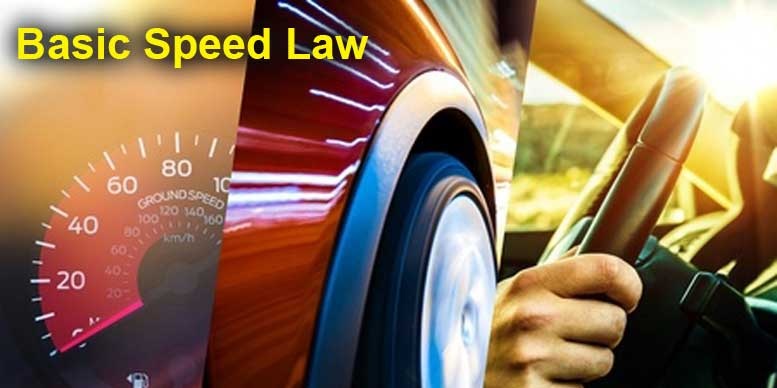Introduction to The Basic Speed Law Says That
The Basic Speed Law is a fundamental aspect of traffic safety, emphasizing the importance of driving at speeds that are appropriate for the conditions, regardless of posted speed limits. It serves as a cornerstone in maintaining road safety for all users. In this article, we will explore what the Basic Speed Law says, its implications for drivers, and how it contributes to preventing accidents and ensuring safer roads for everyone.
Table of Contents
What Is the Basic Speed Law?
The Basic Speed Law states that a driver should not drive faster than what is reasonable and prudent under the current road conditions. While many areas have posted speed limits, these limits are not always the appropriate speed to drive at during certain conditions. For example, if the weather is bad, roads are wet, or visibility is poor, the law requires drivers to slow down even if the speed limit is higher.
This law takes into account various factors such as:
- Weather conditions (rain, fog, snow)
- Road conditions (slippery or under construction)
- Traffic conditions
- Visibility
- Time of day (night driving)
The Basic Speed Law puts the responsibility on the driver to assess the environment and adjust their speed accordingly. It is always up to the driver to ensure that their speed is safe for the circumstances they are facing.
How Does the Basic Speed Law Work?
Under the Basic Speed Law, the driving speed should be adjusted based on:
1. Road Conditions
For instance, if the road is wet or icy, the driver is expected to reduce speed to avoid accidents, even if the posted speed limit is higher. The law recognizes that driving at high speeds on slippery surfaces significantly increases the risk of skidding and losing control.
2. Weather and Visibility
Driving in foggy or rainy weather necessitates slowing down. The driver should adjust their speed to ensure they can stop safely within their field of vision. For example, during heavy rain, it may be unsafe to drive at the posted speed limit because stopping distances increase, and hydroplaning becomes a concern.
3. Traffic and Congestion
In crowded or congested areas, the driver is expected to travel at a speed that matches the flow of traffic, even if the speed limit is higher. The law prevents drivers from exceeding safe speeds when driving in heavy traffic to avoid accidents and ensure smoother traffic flow.
4. Construction Zones
When driving through a construction zone, the Basic Speed Law requires that drivers slow down, even if there are no posted changes to the speed limit. In many cases, construction zones can present unexpected hazards, such as narrow lanes or construction workers on the road, demanding more careful driving.
Why Is the Basic Speed Law Important?
The Basic Speed Law plays a crucial role in maintaining public safety on the roads. Here’s why it is so important:
Ensures Safe Driving Behavior
By focusing on conditions rather than just arbitrary speed limits, the Basic Speed Law ensures that drivers are always adjusting their speed based on their immediate environment. This promotes safety and prevents reckless driving, especially under changing weather and road conditions.
Protects All Road Users
The law doesn’t just apply to cars and trucks. It protects pedestrians, cyclists, and other vulnerable road users by ensuring that drivers are not exceeding speeds that could cause harm in the event of an accident.
Prevents Accidents
Accidents often occur because drivers fail to adjust their speed for road conditions. Whether it’s due to speeding in heavy rain or driving too fast on a slippery road, the Basic Speed Law encourages drivers to be mindful of their surroundings and adjust accordingly.
Reduces Liability
By adhering to the Basic Speed Law, drivers can avoid traffic tickets and potential liability for accidents caused by driving too fast for conditions. It can be a critical factor in proving negligence in accidents, especially in cases of road-related incidents.
Consequences of Violating the Basic Speed Law
If a driver is found to be driving too fast for conditions, even if they are not exceeding the posted speed limit, they can be ticketed or even charged with reckless driving. Here’s what could happen:
- Traffic fines: Drivers who violate the Basic Speed Law can face fines or citations. These fines may vary depending on the severity of the offense and location.
- License points: In some jurisdictions, a violation of the Basic Speed Law could result in points added to the driver’s record, which can lead to higher insurance premiums or even the suspension of the driver’s license.
- Accident liability: If an accident occurs due to excessive speed, the driver may be found liable for damages. This can result in legal fees, compensation for victims, and higher insurance costs.
- Reckless driving charges: In more serious cases, where the driver’s speed is deemed to be highly dangerous, they could face reckless driving charges.
Real-Life Example of Basic Speed Law in Action
Imagine you’re driving in foggy weather where visibility is severely limited. The posted speed limit might be 65 miles per hour, but due to the low visibility caused by the fog, it is unsafe to travel at that speed. In this case, the Basic Speed Law would require you to reduce your speed to a safe level based on the conditions, even though you might be driving under the posted limit.
How to Comply with the Basic Speed Law
To comply with the Basic Speed Law, it is essential for drivers to:
1. Adjust Speed for Conditions
Always evaluate the road conditions and weather patterns before driving. Slow down if conditions are hazardous, such as when it’s raining, snowing, or foggy.
2. Know Your Surroundings
Pay attention to traffic flow and adjust your speed if necessary. Look for signs of construction or obstacles on the road that could require you to slow down.
3. Follow Local Traffic Laws
In some places, the Basic Speed Law may have specific regulations regarding school zones, construction zones, or areas with heavy pedestrian traffic. Always be aware of the local traffic laws and adhere to them.
4. Always Drive Defensively
Even if you feel the posted speed limit is safe, always drive defensively and be prepared to stop or slow down at a moment’s notice. Anticipate sudden changes in traffic conditions, such as a car braking in front of you, and adjust your speed accordingly.
Conclusion
The Basic Speed Law is a vital tool in promoting safe driving habits and preventing accidents. By requiring drivers to adjust their speed based on road, weather, and traffic conditions, it ensures that all road users can travel safely. Drivers should always remain aware of their surroundings and adhere to the Basic Speed Law to avoid violations, accidents, and penalties.
Remember: While posted speed limits are important, adjusting your speed for the conditions is just as crucial. Always make sure that you are driving at a safe speed based on current road and traffic conditions, even if it means going slower than the posted speed limit.
Disclaimer: The information provided in this article is for general informational purposes only. It is not intended as legal advice. For specific legal concerns or traffic-related questions, please consult a qualified attorney or local authorities. Always adhere to your local traffic laws and regulations.




